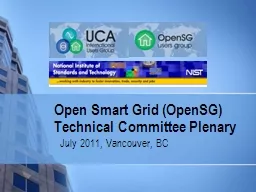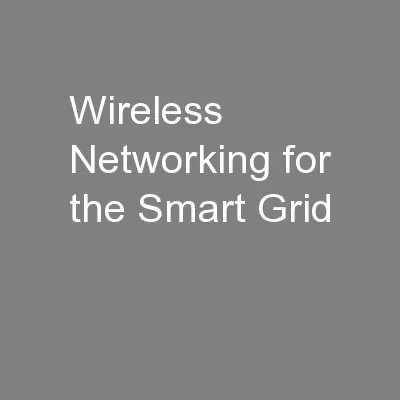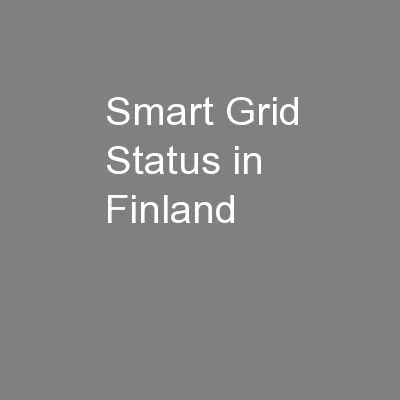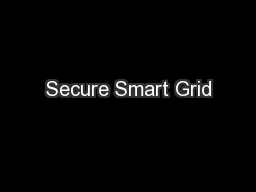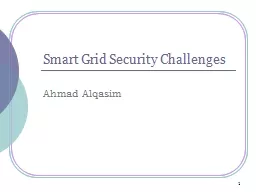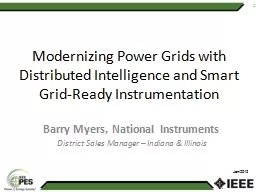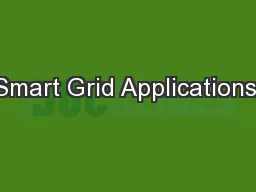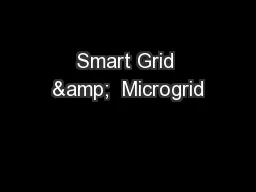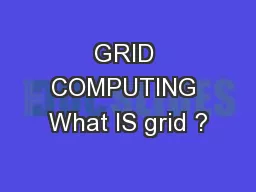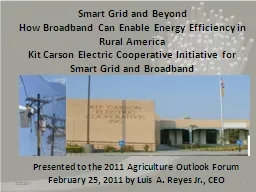PPT-Open Smart Grid (OpenSG)
Author : stingraycartier | Published Date : 2020-06-15
Technical Committee Plenary July 2011 Vancouver BC 2 UCA OpenSG Summer Meeting Vancouver BC CANADA eh Host BC Hydro Contact David De Yagher July 18 21 2011
Presentation Embed Code
Download Presentation
Download Presentation The PPT/PDF document "Open Smart Grid (OpenSG)" is the property of its rightful owner. Permission is granted to download and print the materials on this website for personal, non-commercial use only, and to display it on your personal computer provided you do not modify the materials and that you retain all copyright notices contained in the materials. By downloading content from our website, you accept the terms of this agreement.
Open Smart Grid (OpenSG): Transcript
Technical Committee Plenary July 2011 Vancouver BC 2 UCA OpenSG Summer Meeting Vancouver BC CANADA eh Host BC Hydro Contact David De Yagher July 18 21 2011 3 Agenda. 1 716 60 382 16 73 18 18 20 25 D4110 98 91 58 10 45 14 29 D4111 47 279 241 170 22 92 12 32 D4112 315 851 213 428 121 276 37 80 D4117 947 2358 1105 1357 647 823 95 493 86 86 D4124 283 494 152 358 173 499 296 3471 35 35 D4125 381 754 74 304 17 140 83 O -. Towards Sustainable Energy Solution-. Presented by:. Pawan Kumar Agrawal. Executive Director & Regional Business Leader,. Infrastructure Banking Group, . Wholesale Banking. February 12, 2014. Strictly Confidential. Narasimha. Chari. Chief Technology Officer. Technology and products company. Outdoor mesh routers and network management software. 800+ customers. in 50 countries. 40+ patents. Founded in 2000. Headquarters in Sunnyvale, CA. Country/Economy Smart Grid Status. High priority technical needs for smart grid development and/or deployment. Research and Development program:. 1. ISGAN. 24.01.2012. APEC-ISGAN Smart Grid Test Bed Networks Workshop. Edward Chow. Department of Computer Science. University of Colorado at Colorado Springs. SSG. Chow. 1. What is Smart Grid?. automated, widely distributed energy delivery network . characterized by a two-way flow of electricity and information, . Ahmad Alqasim. 1. Agenda. Problem Statement. Power system vs. smart grid. Background Information. Focus Point. Privacy Attack. Privacy Attack Countermeasures. Jamming attack. Jamming Attack Countermeasures. Barry Myers, . National Instruments. District Sales Manager – Indiana . & Illinois. 1. Jan/2012. Our Challenges. Smart Grid is an umbrella term defining multiple efforts for modernizing power systems. Viewpoint of an Electrical Power Engineer. Francisco de Leon . October 2010. Electrical Power Group. . http://www.poly.edu/power/. . Poly is the only school in the NYC Metropolitan area that offers a . SAIEE. Conference. by. Dr. M Bipath. 1. Contents. Smart Grid ecosystem. The South African Smart Grid Initiative (. SASGI. ). Drivers for change. Smart Grid an enabler to address industry challenges. Renewable Energy. Pilot Projects and Lessons Learned. Sandra . McCardell. , MBA, LEED AP BD&C. President. 11. th. Annual . PQSynergy. International Conference – . Septmber. 2011 - Chiang Mai, Thailand. Renewable Energy. Pilot Projects and Lessons Learned. Sandra . McCardell. , MBA, LEED AP BD&C. President. 11. th. Annual . PQSynergy. International Conference – . Septmber. 2011 - Chiang Mai, Thailand. R&D. Steve . Bossart. Senior Energy Analyst. U.S. Department of Energy . National Energy Technology Laboratory. Military Smart Grids & . Microgrids. Conference. May 1-2, 2012. Smart Grid & . Interconnected computer systems where the machines utilize the same resources collectively. . Grid computing usually consists of one main computer that distributes information and tasks to a group of networked computers to accomplish a common goal.. Kit Carson Electric Cooperative Initiative for Smart Grid and Broadband. Presented to the 2011 Agriculture Outlook Forum . February 25, 2011 by Luis A. Reyes Jr., CEO . 2/25/2011. 1. 2/25/2011. 2. History & Background.
Download Document
Here is the link to download the presentation.
"Open Smart Grid (OpenSG)"The content belongs to its owner. You may download and print it for personal use, without modification, and keep all copyright notices. By downloading, you agree to these terms.
Related Documents

